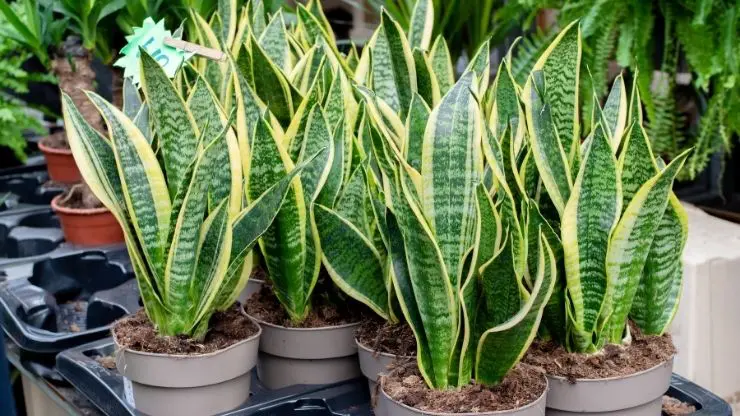Yes, you can plant two snake plants together in the same pot or container.
Even different varieties of snake plant – such as variegated and non-variegated – can be planted together. This combination makes a beautiful and interesting statement in any room.
Snake plants like to be slightly root-bound, so planting two (or even more) plants in a larger container just makes sense. You never want to have a single snake plant in a large pot that’s too big for its roots to fill in a reasonable amount of time.
When to Combine Snake Plants
If you have a mature snake plant established in a container and it doesn’t need to be repotted, I would avoid moving it to another container or combining it with other plants right now. When you have a good thing going, don’t disturb it!
Here are some good times to combine your plants:
- You’ve just purchased two (or more) new snake plants from a nursery and they need to be repotted in a larger container
- You have two or more snake plants that have outgrown their current containers
- You are dividing a larger plant and need to repot the smaller divisions
How to Plant Two Snake Plants Together
If your snake plants are already in containers, grasp the leaves and pull the pot gently from the bottom. If you’re removing from a plastic container, squeeze it to release the soil. If the container is ceramic, use a pencil to loosen the soil around the perimeter of the pot.
Once you get the plants out, gently remove any loose soil from the root ball with your fingers. If roots are compacted, loosen them gently with your fingers too.
Prepare your new container by filling it with potting mix to about an inch from the top. Place your two snake plants into the center of the container, and cover the roots with soil. Do not mound it up, but try to keep the soil even.

Press down gently. Don’t pack the soil too tightly. Lightly water the soil just to moisten, and move the pot to a medium light location. It might take a few days for the plants to settle, but if you’ve treated them nicely – they should recover and begin growing soon!
Tips on Combining Snake Plants
Make sure you have a container that’s large enough – but not too large – to hold both plants. It’s hard to recommend an exact size without knowing the size of your plants. But in general, it’s better to use a smaller container than one that’s too large.
Use a high-quality succulent potting mix. I like this one by The Next Gardener. It’s the best formula I’ve found. My snake plants and other succulents thrive in it.
Center the plants in the container. If you’re combining a smaller plant with a larger plant, place the larger plant in the back of the container and the smaller plant in front. This way, you can see all the foliage on display.
Snake Plant Care After Repotting
After potting your two snake plants together, keep them out of direct sunlight. You want the roots to grow in the new pot and high light can stress the plant. Snake plant is a low-light plant at the best of times, but especially now.
A week after repotting, resume a normal care regimen. You might want to read my complete snake plant care guide for more information, but I’ll summarize basic care instructions here:
- Keep temperatures between 60 and 75 degrees F (15 – 24 degrees C).
- Provide bright, indirect light for most of the day.
- Water once every 7 – 10 days at most in spring through fall. In winter, water even less. Snake plant tolerates dry conditions, but over-watering will kill it.
- Fertilize once a month in spring through fall. Do not feed in winter.
- Clean the plant’s leaves occasionally with a soft, damp cloth.
No special care is required after your plants become established, since they will basically function as a single plant.





